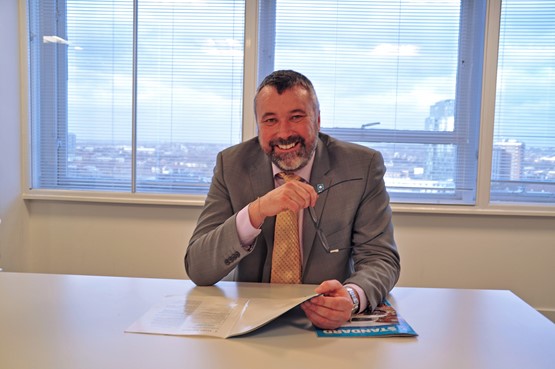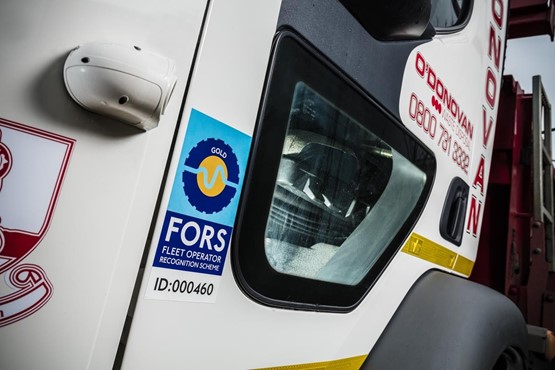"We take complaints seriously; we act”, says John Hix as multiple schemes compete for national supremacy in van and truck accreditation. By Stephen Briers
Two years ago, Freight Operator Recognition Scheme (FORS) and Freight Transport Association (FTA) had a very public spat when the latter launched a rival truck accreditation programme.
A war of words ensued about whose scheme was best until a number of fleets with representation on both stepped in to, in their words, “bang some heads together”. All went quiet.
Then the Driver and Vehicle Standards Agency (DVSA) had a go, perhaps less intentionally.
At the launch of its Earned Recognition initiative in May, chief executive Gareth Llewellyn commented that it was “not so different from FORS – it will be the ultimate national scheme”.
Understandably, John Hix (below), FORS concession manager, took exception. FORS, which celebrates its 10th anniversary this year with its 5,000th member, is unique in covering every aspect of managing a fleet, he says.

“It’s not just the legal compliance – that’s a given. It’s much wider than that,” Hix says.
“It covers qualification of managers and drivers, operations, routing, scheduling, performance management, collision management and reporting, environmental aspects and safety.
“No other scheme does all this.”
The programme is run by Aecom in partnership with the Chartered Institute of Logistics and Transport (CILT), which manages governance with the standards and advisory group (dubbed GSAG), consisting of industry stakeholders, enforcement bodies, fleets (including Skanska, Tarmac, DHL, Travis Perkins and Veolia) and, perhaps a touch ironically, DVSA.
The group decides the requirements set out in the FORS standard, including the management of the fleet and the vehicle, driver and operation requirements that members are audited against.
Conceived by Transport for London in 2008, and administered by Aecom from the start, the company took on full responsibility for managing and operating the scheme in 2015.
It had grown far beyond the confines of London, with two-thirds of members based outside the capital.
The decision caused some consternation among fleets who feared higher membership charges.
It was also one of the catalysts for FTA extending its Van Excellence programme into trucks.
FORS believes those fears – partly based on a belief that every depot would be audited and charged – were unfounded.
“It has to wash its face commercially, not rely on the public purse,” says Hix. “And it does do that now.”
Fees have been unchanged since they were introduced three years ago.
They consist of an annual membership based on fleet size and a charge per audit, carried out by Fleet Source. However, only a proportion of depots are audited each year, typically 20% for larger operators.
Hix adds: “If you have internal audits, we will approve them to deliver FORS audits which is a very cost-effective way to be accredited.”
Key to the integrity of any accreditation programme is whether it has teeth. What happens when an operator transgresses?
“We check and investigate. We allow the operator a chance to say their piece,” Hix says.
“But our procedure allows us to suspend companies and then give them an enhanced audit to return. Or we can terminate them and downgrade them for a minimum of six months and then they have to have a series of enhanced audits.”
Last year, FORS investigated 490 complaints, typically from the police or members of the public, and 556 potential breaches. It suspended 12 companies and terminated two.
“We take complaints seriously; we act,” Hix adds.
FORS is rooted in truck accreditation but most members have a mix of trucks and vans. Its strategy is to broaden both its geographic spread and its vehicle spread; this year, for example, it updated the standard to incorporate bus and coach fleets and motorcycle fleets.
Membership has almost doubled since Aecom won the concession, with the 5,000-plus fleets operating some 130,000 vehicles. More than 500 members are van-only fleets.

“FORS is just as relevant if you are running a van fleet as it is for a truck or a mixed fleet,” says Hix.
“This year, we anticipate 10% growth in operators and we will continue to target sensible growth in that region.”
Unusually for a standards programme, the membership profile consists of a small number of large operators and a long tail of smaller operators, some running just one vehicle.
Hix explains: “We’ve been successful in signing up the smaller fleets because of our support tools and training, such as our FORS practitioner half-day workshops on the practical aspects of running a fleet. We can also give them a management system to help run their fleet more efficiently.”
More than 1,000 people have completed one of the 10 training modules for the chance to be called a qualified FORS practitioner.
The modules sit under the FORS Professional Training umbrella which includes eModules and eLearning for drivers and managers. More than 150,000 people have been trained to date.
Entry to FORS is via the Bronze accreditation. It offers basic legal compliance, some elements of operator best practice, such as licence checks, and discounts on products and services from associate companies for safety equipment, training, insurance and fuel services.
It is also the minimum requirement for companies wishing to tender for work with TfL and a host of other organisations.
Bronze accounts for the majority of members, but those looking to take it a stage further can apply for silver and gold membership. Both demand greater monitoring and evidencing of performance, with more emphasis on safety and efficiency.
There is also more focus on safety equipment, such as in-cab cameras, and safe urban driving is mandated.
Gold is about sustained performance improvements plus sustainability and reducing environmental impact. It also requires members to write up case studies about their performance and to investigate opportunities for modal shift into non-road transportation.
They are expected to become FORS champions and specify the standard for their own supply chains.
To date, 1,000 companies have achieved silver accreditation and 250 gold.
These operators currently face separate audits for each level at different times of the year, but Hix hopes to unify the process with a single date on a combined evidencing form.
“We encourage progression, and we have seen a growing proportion of companies that have progressed, but we have to simplify the process,” he says.
“It’s a big step up between bronze and silver. However, this is where we hold hands with CLOCS (Construction Logistics and Community Safety standard) – if you have FORS silver, you will be compliant with CLOCS.”

Association with other standards is very much on the agenda, including DVSA’s Earned Recognition scheme.
“We’re flattered that they aspire to be the same type of idea as FORS,” Hix says.
“We work with them on Earned Recognition, but that is focused on the O-licence which is only one element of FORS. However, there is the potential to do a combined audit with DVSA.”
He adds: “We would also be happy to do this with other certification bodies, but no one has taken up the offer yet.”
Why fleets might miss out in Bronze audit
Not everyone passes a FORS inspection first time – the rate is 69% for the Bronze audit. Below, FORS provides the five principal reasons for failure.
Professional development: Failure to provide the required mandatory training courses, or to produce a professional development plan for all transport-related staff.
Vehicle manoeuvring: Failure to have policy and appropriate risk assessments, to communicate these to relevant staff and to get the transport-related workforce to acknowledge receipt of these.
Document review: Failure to conduct annual (or sooner if circumstances dictate) review of company policies and procedures and failure to ensure senior management has acknowledged the review and that reviews are cascaded to transport-related workforce.
Tyre and fuel management: Failure to have a fuel and tyre management policy. Failure to demonstrate monitoring and fuel consumption management.
Personal safety in or around vehicles: Failure to have policy and appropriate risk assessments in place. Failure to communicate these to relevant staff. Failure to get the transport related workforce to acknowledge receipt of these.
Failure isn’t the end of the road, though. Companies are offered a follow-up audit within 30 days and 98% pass




















Login to comment
Comments
No comments have been made yet.